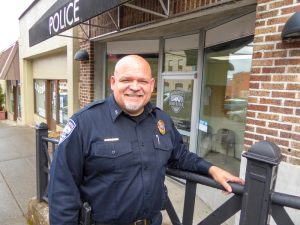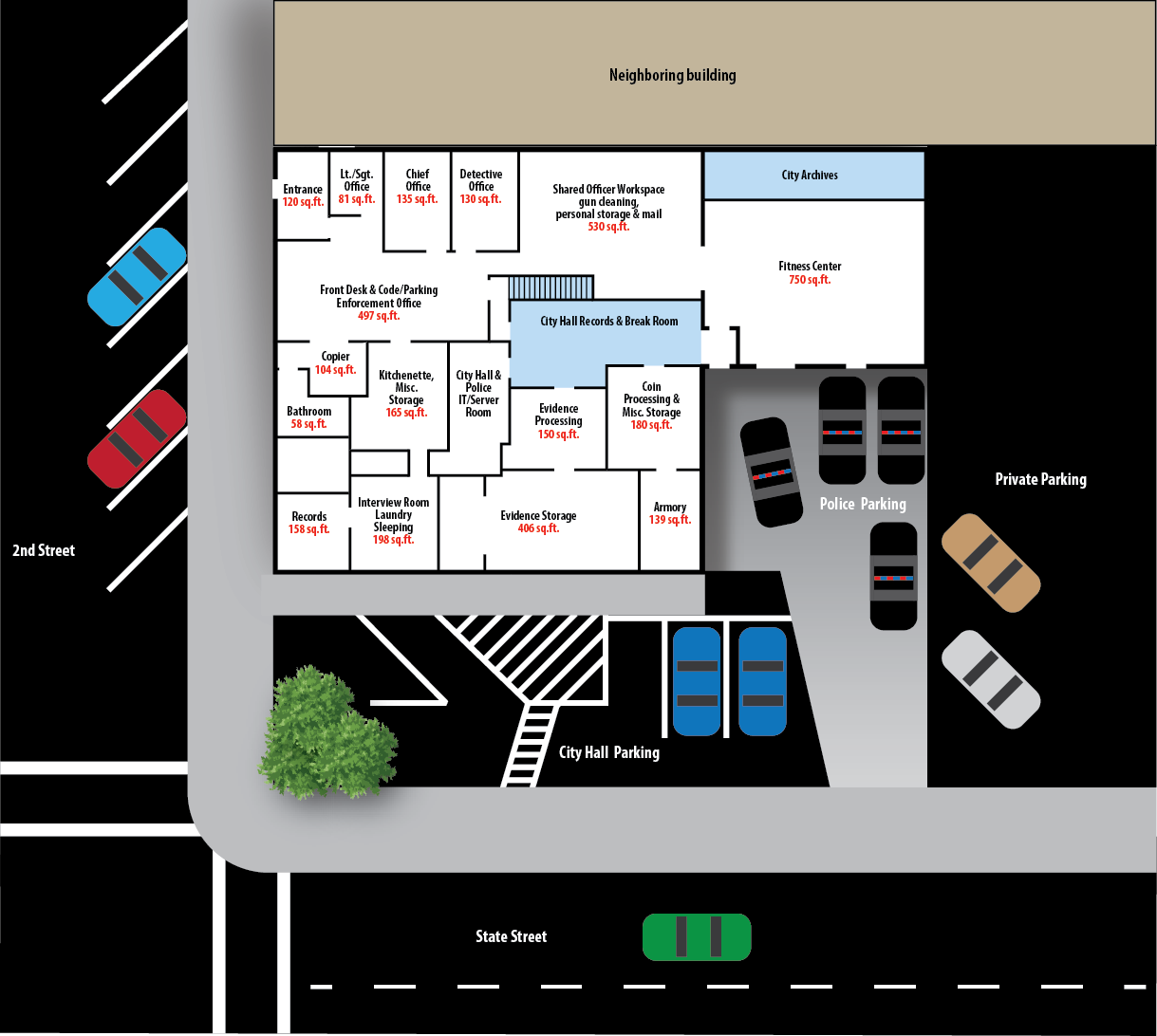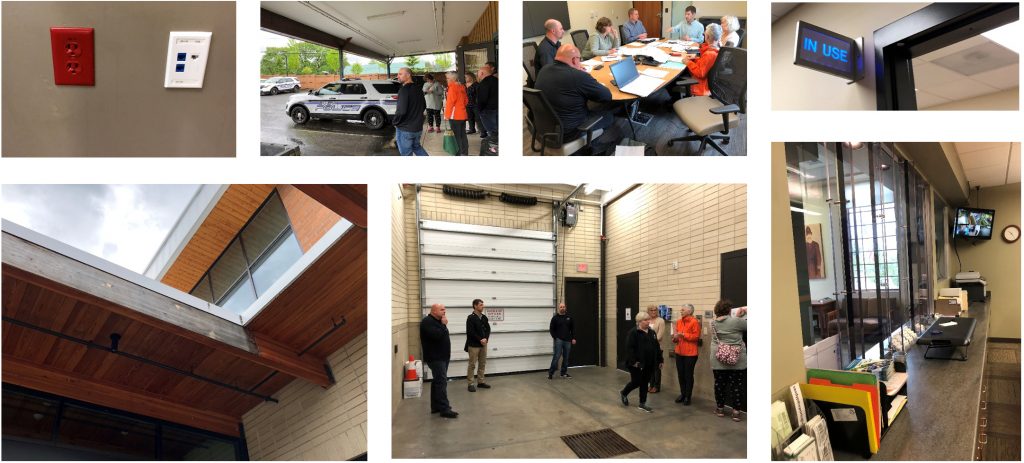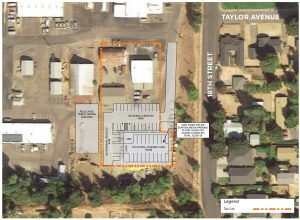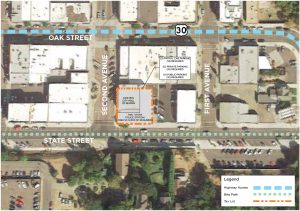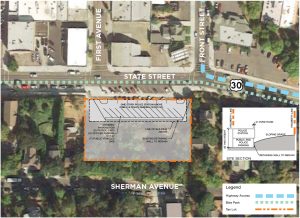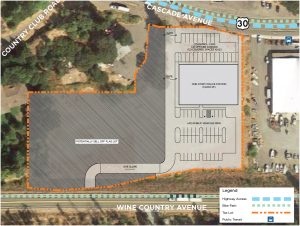Hood River Police – Police Facility Planning

The City of Hood River is actively planning for its future public safety facility needs. Modern public safety facilities support effective policing by providing purpose-built spaces that help officers perform their job. Examples include training rooms where officers can receive the latest training without the need to travel, evidence processing and storage facilities that reduce the time officers are away from patrol, and secure interview rooms with audio and visual recording equipment. The goal is for the facility to be an asset that helps officers perform at their highest level, supporting more availability for calls for service, successful investigations, and overall emergency readiness.
The City of Hood River Police Department has never occupied a facility purpose-built to support modern policing. Since at least the 1970s, department operations have periodically shuffled between sharing space at various government and privately-leased office spaces in the downtown area.
Prior to 2010, the Police Department and Municipal Court occupied both floors of 211 2nd Street where City Hall is now located. The City sold its property at 301 Oak Street in order to consolidate City offices in a remodeled City Hall during the Great Recession.
Police were moved to the daylight basement of the building in 2010. The basement received only minor updates with the understanding that the space would be a temporary home for the department. The location is not feasible as a permanent home due to many shortcomings of the building. The space lacks basic functionalities for modern policing and is unable to provide as is for growth. Click Here for a virtual tour of the existing facility.
There have been several attempts to build a tailored public safety building but none have been successful. In 1996 & 1997, planning activities were completed for several possible sites, including Morrison Park, the State Street Lot, and City Hall location. Consideration was given to co-locating the Police Department with the Fire Department when the Myers Parkway Station bond was floated in 2008, but ultimately only the Fire Station and apparatus replacement was requested of voters.
Below are links to prior City newsletter articles on the Police Facility Project:
Spring, 2019 “City Assesses Police Department Facility”
Fall, 2019 “HRPD Facility study moves to site selection”
The Hood River Police Department has been located in the daylight basement of a 100-year-old Building since 2010. Originally a Fire Engine drive-through garage before being converted to offices, the space includes substandard rooms for basic policing functions and in some cases utilizes rooms for multiple and at times incompatible uses. CLICK ON THE IMAGE BELOW TO TAKE A VIRTUAL TOUR OF THE EXISTING FACILITY
Aged Century-old Building
- Converted Fire Bay
- No Back-Up Power
- Masonry Construction
Evidence Processing and Storage
- Undersized
- No Ventilation
- Chain of Custody Challenges
- No Outdoor Evidence Locker (for larger items)
Combines Incompatible Functions
- One Room serves for Interviews, Meetings, Laundry and Breaks
- No Private Interview Room(s)
- No Private Off-duty Quiet Room
- No Break Room
Lacking Standard Functions
- No Meeting Room
- No Training Room
- No Locker Rooms
- Inadequate Storage (for records/evidence)
- Vehicle Access Issues – Sloped, Poor Visibility Entering Roadway, Uncovered & Unsecured Driveway
2018
The Hood River City Council prioritized planning for a future police facility at its 2018 Goal Setting session and has reaffirmed its commitment each year since. A standard police space needs assessment includes six steps outlined in the graphic below.

2019
The architectural firm Mackenzie was awarded a competitively bid contract in 2019 to perform the Space Need Assessment. The contract award City Council Item is available HERE. Mackenzie’s contract was later amended to only include the “Phase I” tasks listed above.
Mackenzie held onsite programming workshops with Police Command and City Staff in order to understand existing building functions. The firm forecast community growth and calculated the department’s future space needs, initially estimated at 16,124 sq. ft. The April, 2019 City Council Update with this initial analysis is available HERE.
The project team next toured similar sized facilities in the region to gain a better understanding of layout and the functionalities of a modern police station. Additional information on these tours is below under the tab “Facilities Visits”. The initial space program of 16,124 sq. ft. was revised downward to 13,178. The preliminary space needs report was accepted by the City Council in August, 2019. The space needs report can be found HERE and the PowerPoint presentation to the City Council is HERE.
2020
Seven potential sites that could accommodate an adequately-sized facility were analyzed and ranked by consultants and City staff based on industry criteria including access, size/shape of site, costs to acquire and develop, central location, proximity to other government locations, security, and land use compatibility. Site rankings and selection were discussed with City Council on May 26th (5/26/2020 City Council Item available HERE) and August 24th (8/24/2020 City Council Item available HERE). Some properties examined were owned by the City and others would need to be acquired. Site evaluations includes pros and cons to each of seven locations. Public Works Yard, City Hall, 3540 Cascade Avenue, State Street Lot, Current Pool Location, Cascade Lot, Columbia Lot – See “Site Evaluations and Selection” tab below for more detail.
After the August 24th discussion, City Council wanted to ensure there was no possibility of a joint project with Hood River County before selecting a site and moving forward with preliminary design for a city-only project. Hood River County had engaged in its own facility planning work in 2015, developing its own space needs program and site evaluations.
During this period of time, the City was also approached by the non-profit Columbia Gorge Children’s Advocacy Center (CGCAC) about potentially sharing space in a new building. CGCAC is a non-profit organization that interviews suspected victims of child abuse for legal proceedings, performs medical evaluations, provides child advocacy, makes mental health referrals, and generally provides coordination of child victim services. The organization has outgrown their office space and is searching for a new permanent location. The organization estimates a need for 4,000 square feet.
Hood River County Commissioners held a discussion on the topic of a joint Courthouse, Police Station and Sheriff’s Office at their September 21st Regular Meeting. A link to the 9/21/2020 Hood River County Board of Commissioners Meeting Packet is available HERE. The County Commissioners were uniformly in favor on continuing the discussion on a joint facility, but did not want to slow the City’s timeline. Identified challenges to a joint facility included funding and identification of a suitable location. The County Commissioners wanted to know the project cost, which will determined through the preliminary design phase, and wanted to identify sources of outside funding.
After receiving input from Hood River County, the City Council resumed deliberation on the next steps in the project at their September 28th Regular Meeting. The City Council Item from the meeting is available HERE. The City Council chose to wrap up the existing project (final report HERE) and move forward with a new solicitation for an architectural firm to complete the following two projects:
- Preliminary design and cost estimation for a police facility that accommodates CGCAC and includes a parking garage on the Columbia Lot.
- Site analysis, preliminary design, and cost estimation for a joint City/County/CGCAC public safety building, including replacement parking, as necessary.
City, County, and CGCAC are currently working to draft and issue this solicitation.
As part of the process, city staff and council members visited 3 recently constructed police facilities in the Portland/Willamette Valley area. The tour group met with staff of the other departments to learn what worked well and what they would have changed in their new departments. Examples to emulate included labeling electrical outlets connected to emergency power (upper left photo), adding “in use” signage outside of interview rooms to limit noise (upper right photo), and having covered parking for in-use patrol vehicles (upper central photo). Examples to avoid included using unfinished wood for exterior applications (lower left photo) and uneconomical desk heights that require aftermarket add-ons later (lower left photo)
7th Ranked – Public Works Yard
PROS
Proximity to Fire Station, publicly-owned, central location, flat site
CONS
Security and access issues, depends on acquiring and re-configuring county property, environmental remediation, requires some site demolition, delays project several years, frontage improvements required
Summary
The public works yard ranked lowest of all seven sites. This site has significant security and access issues for a 24/7 public facility. It will also require purchasing property from Hood River County and re-configuring their buildings elsewhere on the Yard. Development costs are a major risk as it will take additional analysis to estimate the amount of environmental remediation necessary for redevelopment. The advantages of the site are proximity to the existing Fire Station, public ownership, and location in the geographic center of the community.
6th Ranked – City Hall
PROS
City-owned, connected to other city departments, utilizes downtown parking
CONS
Attached to 100-year-old building, no secure vehicle access, limited space, expensive construction
Summary
The next lowest ranked option is further remodeling and re-configuring City Hall. The positives of the site include maintaining a connection to City Administration and utilizing downtown parking assets. However, fusing a new building built to essential public safety standards on to an existing 100-year old structure is a mismatch in useful lifespans and adds unnecessary retrofitting costs. The site also doesn’t support a sally port that was identified as a need in the space program. Lastly, the basement of City Hall is already needed for community development functions as the 2nd floor of City Hall is no longer sufficient for the number of existing staff.
5th Ranked – State Street Lot
PROS
City-owned, close to City Hall
CONS
Cannot accommodate a Sally Port, expensive two-story construction over parking lot
Summary
This parcel requires building on stilts over the ground floor lot to preserve parking. The location is near City Hall and on publicly owned land. However, the site will have high construction costs associated with building a second-floor building into a steep hillside. ADA access requires an elevator which will reduce parking availability and add expense. The sally port designated as a need in the space program is not possible on this site.
4th Ranked – 3540 West Cascade Ave
PROS
Large, level site, close to freeway access. Excess property can be used for other City objectives (ex. recreation and affordable housing)
CONS
Privately-owned, access must be from Wine Country requiring an expensive ramp, no off-site parking
Summary
This parcel is a greenfield development opportunity for the new police facility. The site is about twice the size needed, allowing for other development opportunities like affordable housing or parks. The disadvantages are cost of acquisition and ingress/egress. Access from State Hwy 30 is not feasible for left in and out turns. This means that primary access will need to be from a ramp from Wine Country Ave. The lack of on street parking requires that peak parking demands be met by a large off-street parking lot. The remote location also creates undesirable disconnection from other City facilities.
3rd Ranked – Cascade Lot
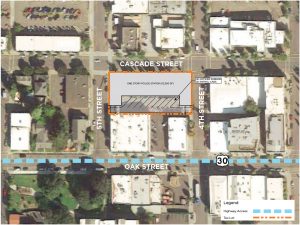
PROS
City-owned and close to City Hall. Compatible zoning on a build-able lot with good utility access
CONS
Removes central parking location. Urban Renewal Funds are available to provide an offsetting parking structure at the Columbia Lot
Summary
The Cascade lot presents the best mix of beneficial geographic attributes and feasibility. The location keeps the Police Department located downtown with good access to public parking and transit. Urban Renewal Funding can be deployed to replace lost off-street parking by building a structured parking garage one block away at the Columbia lot or acquiring other surface spaces. Development costs on the site are minimized because the site is already served by utilities and fits with district zoning. Because the site is City-owned, negotiations with third-party landowners are not necessary before the project proceeds.
2nd – Current Pool Location
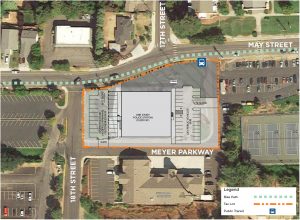
PROS
Publicly-owned, centrally located near Fire Dept.
CONS
No timeline for pool relocation and replacement
Summary
The Hood River Valley Parks and Recreation pool location is ideal in many ways. The site is in the geographic center of the City and next to City Public Works and Fire Department offices. The site’s primary obstacle is the timeline and lack of site control. If this site is selected, then the police facility project will be paused indefinitely until a new parcel for the pool is identified, funds secured for its relocation, and the current site vacated. This risks the City’s ability to run a bond election before the Fire Station levy expires. It also leaves the department in a sub-standard facility for an extended period.
1st Ranked Columbia Lot
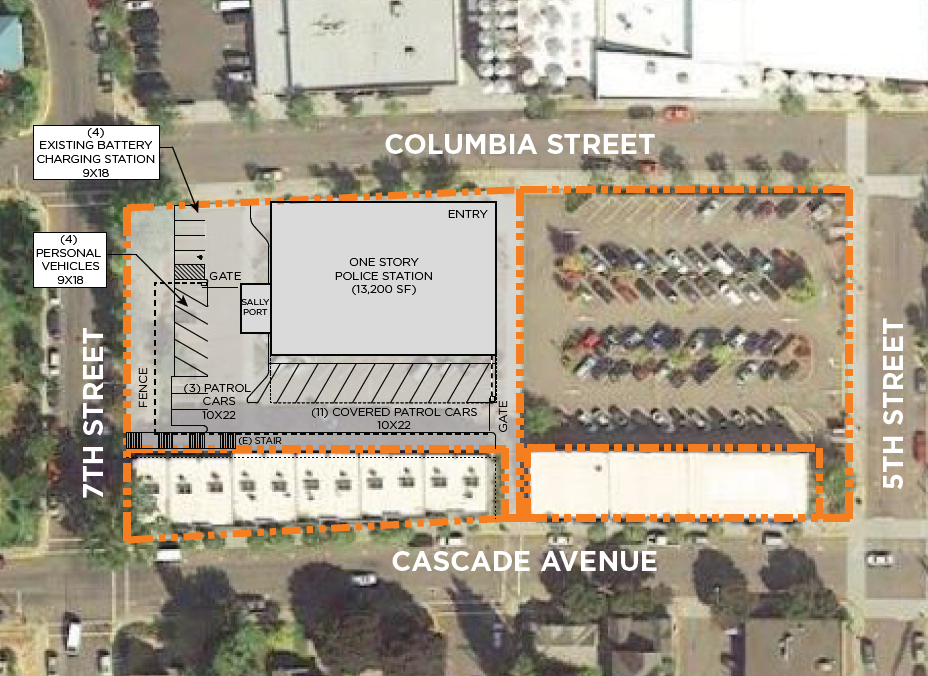
PROS
Located near the heart of downtown, City-owned, build-able site with good vehicle flow, utilizes downtown public parking parking
CONS
Impacts residential views, limited non-metered public parking, frontage improvements required, will require a parking garage to replace lost public parking
Summary
The Columbia Lot was added by City Council suggestion at the May 25th City Council Meeting. The parcel scored very highly on the IACP rating criteria. This is because the Columbia lot has the same advantages as the Cascade Lot, but is larger which allows for simpler design and more police vehicle parking. The Columbia lot will eliminate 60 public parking spaces as compared to the loss of 48 spaces in the Cascade lot. A parking garage or acquisition of surface parking is an eligible expense for the Columbia Cascade Urban Renewal District to make sure all lost downtown parking spaces are replaced.
Once a site is selected and preliminary design complete, City Council will decide whether to seek voter approval of a general obligation bond. The City’s 2008 Fire Station bonds will retire in 2022 creating a natural opportunity to ask voters to extend the City’s bonding authority for the community’s first-ever purpose-built police facility. An analysis by the City’s financial advisory firm, Piper Sandler & Co, calculates that existing bonding authority will generate approximately $14.3 million if current tax rates are extended for an additional 20 years.
Send your questions to w.norris@cityofhoodriver.gov to help populate this section of the webpage
How will a Police Facility change my property taxes?
This depends on the final facility design and future construction costs. Any tax backed borrowing for a Police Facility is also dependent on voter approval. However, the existing Fire Station can be used as a “for instance” of possible financial impacts.
In 2008, voters authorized up to $6 million in bonding authority at an estimated cost of $0.98 per $1,000.00 of assessed value (AV) to finance a new fire station and apparatus. Because the city grew faster than expected, the repayment of the Fire Station bonds have only required about $0.70 per $1,000.00 AV in recent years. An example home with a $450,000 real market value and AV of $288,000 for calculation of property taxes has annual tax bill of $201.60, or $16.50 per month, at $0.70 per $1,000.00 AV.
The Fire Station bonds will be fully repaid in 2022. A 2020 financial analysis estimated that if voters authorized the continuation of an existing levy of $0.70 per $1,000 AV for an additional 20-years, it would produce $14.3 million for a Police Facility. If bonding authority is not extended past 2022 for a police facility then property taxes will decrease.
Isn’t Affordable Housing a more urgent need?
Increasing affordable housing in Hood River has been a persistent challenge and top tier goal for City Leadership. City efforts to address affordable housing date back to at least the 1990s (Res. 92-07). The most recent efforts are guided by the strategies outlined in the 2015 Housing Needs Analysis, updated in 2019. Strategies include regulating short-term rentals, increasing land use efficiency through Housing Code Updates, and developing affordable housing.
Affordable housing and adequate police facilities are not necessarily an “either/or” choice. The City has committed to promoting local affordable housing options. A future question for voters is if the community also wants its first ever purpose-built Police Facility.
Hood River is already a safe city, how will a purpose-built Police Facility improve services?
Hood River’s Police Officers will keep residents and visitors safe under any circumstance. The question for the Hood River community is whether their police facility is an obstacle to overcome, or an asset that assists, Officers in their duties. The Hood River Police Department has operated in a series of generic office spaces since at least the 1970s. Similar to a doctor in a hospital, chef in a kitchen, or teacher in a classroom, policing is a specialized field that benefits from a purpose-built facility. Modern policing facilities support effective policing in some of the following ways:
- Separated and specifically designed victim interview rooms vs. rooms for in-custody interrogations
- Temporary holding cells so officers don’t have to personally control all in-custody suspects
- Technology enabled systems, such as evidence storage lockers that maintain chain of custody without time-consuming manual processing
- Publicly accessible shared spaces that facilitate community policing principles
- Secure parking that facilitates safe and quick call responses as well as anonymity for informants or crime victims
- Audio visual recording capabilities to assist prosecutions with high-quality evidence
- Modern public safety seismic standards with emergency power for disaster resilience
- Onsite training room for regular skills instruction without the need to travel out of town on duty
Has the facility planning process changed as a result of the Black Lives Matter movement?
The City of Hood River has a long-standing commitment to incorporating equity and inclusion in every aspect of municipal operations. This ethic was built into the existing space needs program, most explicitly in the addition of a public meeting room to facilitate community policing strategies that cannot be accommodated in the current facility. The Black Lives Matter movement was an opportunity to renew and publicly demonstrate the City’s commitment to social justice, which it did through a Use of Force Review and City Council Resolution on Racial and Social Equity (Res. 2020-13). As the City’s basic space needs are translating into a preliminary building design, the organization’s commitment to equity and inclusion will be front and center. The process will also have public outreach components and we hope the public will be involved in creating a facility that fosters trust and partnership between the Police and Hood River Community.
The Waterfront “Lot 1” parcel is empty, why didn’t the City decide to build there?
“Lot 1” in the Hood River Waterfront area is owned by the Port of Hood River. The Port has been actively planning for the development of Lot 1 since at least 2012. A project webpage dedicated to Lot 1’s development planning process is posted at: https://portofhoodriver.com/projects/lot-1-development/
If Lot 1 were available, the Hood River Waterfront is still not an appropriate location for a public safety building. The only vehicular entrance and exit to the area is via the 2nd Street overpass. If this overpass failed during an earthquake or otherwise became impassable due to fleeing traffic during an emergency, police vehicles will not be able to cross quickly.
Why doesn’t the City build on the Public Works Yard?
The shared Hood River County / City of Hood River Public Works yard was studied as one of seven possible locations. More information is available in the “Site Evaluation and Selection” Tab above. However the short answer is that the City only controls about 25% of the Public Works Yard with Hood River County occupying the majority. Finding a suitable replacement location and coordinating the move between the City and County will leave the police operations in sub-standard offices for an indefinite period of time and add many millions in property acquisition, building, and property remediation costs to the project.
I thought the City didn’t have enough money for basic public safety operations, why are they asking for a new building?
The City of Hood River and Hood River County are often confused. Each local governments has completely separate finances, elected governing boards, and dedicated funding sources. Hood River County, like most other Oregon counties, has faced severe financial challenges in recent years and asked Hood River County voters for financial assistance, resulting in the passage of a five-year supplemental operating levy.
While the City of Hood River faced financial challenges in the wake of the Great Recession in 2008, it has been on solid financial footing for many years. The City’s credit rating increased from AA- to AA in 2017, it fully funded its vehicle replacement reserves in 2019, and has remained financially stable through the COVID19 pandemic. While the City is operationally stable, almost no local government is able to pay cash to build a new building that will last for decades. This is why a continuation of the bonding authority that voters originally approved to build the City’s fire station will be needed if Hood River chooses to build its first ever purpose-built police station.
There is not enough parking downtown as-is, why is the City considering building on a parking lot?
The City considered seven different sites and evaluated each against a set of industry criteria. More information on these sites is in the “Site Evaluation and Selection” tab above. The Columbia Lot ranked highest for several reasons, including cost of development, proximity to other government offices, land use compatibility, and transportation access. In addition, the Columbia Lot is a large enough parcel that all displaced parking can be replaced on site with a multi-level parking garage. Downtown Urban Renewal dollars can be accessed to help pay for these parking spaces. As of October 2020, the City is still in the process hiring a architectural team to create a preliminary design for the site. However, at minimum no downtown parking spaces will be lost and the goal is to ultimately increase downtown parking through the project.
Given the City’s climate goals and the need to transition from vehicle-centric transportation, why is replacement (or even increased) downtown parking part of this project?
City leadership must balance competing local needs and goals. Hood River has been a leader in climate action for many years. However there is also a recognition that downtown businesses rely on parking availability for the economic vitality of the community’s urban core. This need was quantified in the downtown parking study completed in 2020. Additionally, when the City accepted the Columbia Property Lot from the Port of Hood River in 1995, the City promised to eventually build a parking garage on the site.
For questions or to offer input on Police Facility Planning, contact Chief Holste at N.Holste@CityofHoodRiver.gov.
